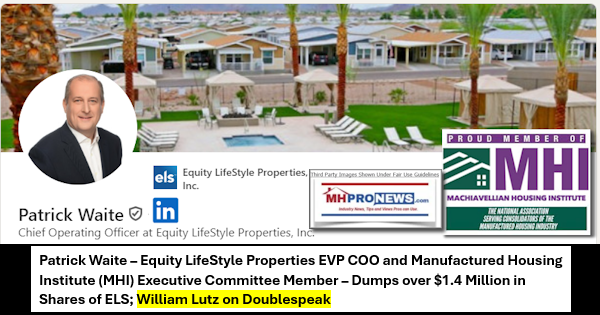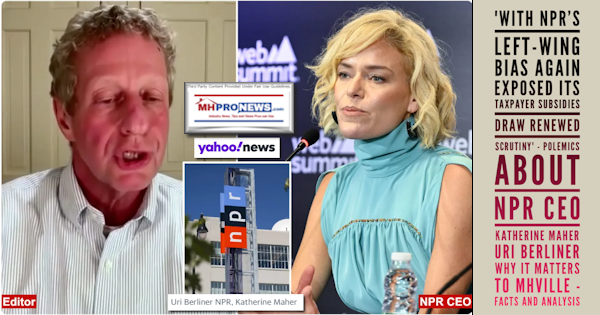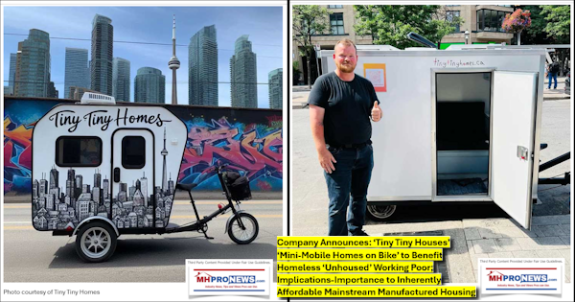Bombshell allegations have been leveled against the Manufactured Housing Institute (MHI) that claim that if they don’t act swiftly, it may become impossible to avoid a sharp downturn for the industry in less than a year. So, in fairness, the MHI corporate board, top staff, and outside attorneys have been asked by MHProNews in a documented emailed inquiry to comment on the concerns raised in the exclusive Q&A posted further below. More on that shortly.
That said, ponder the maxim: ‘You can tell a lot about a person’s or organization’s character by who their enemies are.’
Variations on that pithy notion, per TVTropes, are:
- “You can always judge a man by the quality of his enemies.” — Oscar Wilde.
- “A man’s greatness can be measured by his enemies.” — Don Piatt.
- Or BrainyQuotes which said: “I ask you to judge me by the enemies I have made.” – Franklin D. Roosevelt.
Both the friends and opponents of a person or organization can be revealing is a reasonable takeaway from such notable Quotables.
Wikipedia says that Donn Piatt “was an American journalist, military officer, and public official. Born in Cincinnati, Piatt attended schools in Ohio and began contributing to newspapers as a young man. He started his career as a lawyer and was briefly a judge…” That said, Piatt also remarked: “The person who has no enemies has no followers.” Two other quotations from Piatt: “Life is a campaign not a battle, and has its defeats as well as its victories.” And “To be great one must be positive and gain strength from your opponents.”
The purpose of the Q&A that follows was not to pick a fight between opponents. The wily Mark Twain was correct when he observed that: “The only safe and sure way to destroy your enemy is to make him your friend,” an attribution to that fabled writer per TVTropes. But Piatt is also correct in his observations.
An enemy – or a friend – is generally determined by behavior. That is why what happens in the wake of these explosive allegations related below will speak volumes.
As you read the following exclusive Q&A involving former MHI VP and Manufactured Housing Association for Regulatory Reform (MHARR) founding president, CEO and currently their senior advisor, Danny Ghorbani, keep in mind that MHI has been given an opportunity by MHProNews to comment on these claims. Per an informed source, the following is the ‘first salvo,’ a shot across the bow. But the aim isn’t war with MHI, per Ghorbani.
Ghorbani’s potent thoughts, expert observations, keen knowledge of industry history, and insightful opinions speak for themselves. The Q&A was conducted via email, for maximum accuracy.
MHProNews Q & A with Danny Ghorbani about the DOE’s Final Manufactured Housing Energy Rule
MHProNews QUESTIONS to Danny Ghorbani
Have you seen and read MHI’s recent proposal and plan of action finally opposing the U.S Department of Energy’s (DOE) final manufactured housing energy rule? And if you have, given your knowledge of this important rule and of the industry at large, do you think it a good or a bad proposal? In sharing your insights and given the complexity of the DOE final MH energy rule, will you please explain to our readers some of the key relevant, factual and accurate information about this hot-button topic?
Danny Ghorbani’s ANSWER to MHProNews
Thank you, and yes, I have read the information that MHI released in May, as well as a couple of related interviews that have been published since. Thus, based on that information, once again MHI’s “solution” falls way short of the target regarding a critical and devastating problem that it has helped to create and perpetuate, and which is now on a fast track to be implemented in less than a year to the detriment of the manufactured housing industry and moderate and lower-income American consumers who depend on our industry as their primary source of affordable homeownership. I will try to further explain my thoughts on this matter.
The DOE final manufactured housing energy rule, which was published on May 31, 2022 and will be enforced on June 1, 2023 is a very complex energy regulation resulting from the manufactured housing energy provisions of the Energy Independence and Security Act of 2007 (EISA). It is an extremely harsh, unnecessary, and unnecessarily costly and expensive overkill-regulation for today’s modern, energy-efficient manufactured homes, which, as explained below, should have been dead in its tracks, if MHI had not collaborated and cooperated with DOE and the rules’ proponents from the beginning of the DOE rulemaking process.
That DOE rule, if enforced in its current final version, would drastically affect the very existence of our homes as we know them today and potentially wipe-out nearly 80% production of our industry’s most affordable models, placing them out of the reach of our consumers. And even though we were able to include plenty of guard rails and safety provisions in EISA during the latest stages of the legislative process, DOE has completely ignored them because MHARR was the only stakeholder that tried to hold DOE accountable for compliance with those provisions through the entire rulemaking process, but to no avail.
There are two sequences of actions and/or lack thereof that aptly define MHI’s role in bringing the industry to this critical stage, and one action that might potentially rescue the industry before disaster strikes on June 1, 2023, that is, of course, if MHI decides to cooperate. These sequences are:
A – MHI’s long standing collaboration, cooperation and complicity with DOE and the rule’s proponents at various times since the rulemaking process began over a decade ago;
B- MHI’s belated “deathbed conversion” and ongoing attempt at vindication (albeit, still on the wrong track) once the extremely destructive aspects of the DOE final rule began to be exposed, uncovered and gradually understood (thanks to MHARR) by industry members and consumers, thus forcing MHI to reverse course with its incomplete, half-hearted, “CYA” proposal and plan of action that it now is peddling in Washington, D.C.;
C- What must MHI and the industry actually do in order to make the best out of a fast-moving, terrible and destructive rule before they run out of time, as the clock continues to run?
Now, let’s carefully address and examine all of the above.
A – In my opinion, it is a known fact that MHI worked and closely collaborated with DOE from day one of the rulemaking process for EISA. What is not literally and universally known, is the degree to which such collaboration and complicity facilitated the rule’s advancement at every stage of the rulemaking process until recently. Nor is MHI’s recent hasty reversal of its support for the continuing advancement of the DOE’s destructive rule, any indication as of yet that MHI is truly inclined to fight the final rule and not just posture as MHProNews so aptly puts it, offers a “head fake” to buy and/or waste valuable time, divide the industry’s efforts and resources, while simply running-out the clock. Given MHI’s corrective proposals and plan of action, it is disturbing that MHI still has not admitted that, at the very least, it made mistakes during the rulemaking process and is now willing to help correct matters. In short, MHI can continue to run from its actions that resulted in this destructive DOE regulatory rule, but it cannot run from the existing facts, accurate information and documented material that actually exist and will help to educate manufactured housing industry stakeholders.
In conjunction with this and for the benefit of industry members and consumers, shown below is a brief chronology of MHI’s actions or lack thereof that have been instrumental in facilitating and advancing DOE’s destructive rule since the early stages of the rulemaking process all the way to its later stages. Furthermore, and for better understanding by the readers and stakeholders, this document also includes the corresponding actions by MHARR, the only national organization that has aggressively, constantly, and persistently opposed the DOE’s energy rule from the beginning, based on the DOE’s non-compliance with the key protective provisions of EISA and every step thereafter. One can only imagine what the final DOE’s energy rule would have looked like had MHI, supposedly the national representative of “all segments” of our industry, had also aggressively, constantly, and persistently done the same thing. No doubt that the industry and consumers would certainly be in better shape than they are right now.

B – The above factual outline document becomes even more relevant and important in helping industry members, consumers and opponents of the rule to better understand why MHI has made a 180-degree reversal of its more-than-one decade of support, cooperation and complicity with DOE to advance this destructive regulation to its final stage, all with what MHProNews has correctly labeled as a mish-mash of a proposal. So, with its proverbial cover of cooperation and assistance in advancing the rule blown, MHI throws everything at the wall except litigation, perhaps hoping that something might stick. But with MHARR’s aggressive, constant, persistent, and vigilant opposition to the DOE energy rule, added to the MHARR’s methodical, detailed, and thorough education of the rule’s stakeholders about the destructive nature of the rule, (see, the chronology document numbers 18, 19 & 20 above), MHI’s attempt at vindication via its latest proposal is inadequate and incomplete at best and is arguably worthless and devoid of real and serious solution at worst.
Regardless, MHI is already in a “hole” on the DOE’s egregious final rule, but keeps digging itself, the industry, and consumers a deeper hole by continuing to underestimate the knowledge and intelligence of the DOE energy rule’s stakeholders. This is because based on the MHI’s announced proposal and plan of action, that “plan” mainly consists of two efforts, namely:
- 1- H.R. 7651 – proposed new legislation backed and fully supported by MHI; and
- 2- A proposed revised energy standard that MHI wishes HUD would adopt in lieu of the DOE’s MH energy rule, currently in its countdown to implementation stage.
Regarding number 1, above, aside from MHI’s big talk and wishful thinking, the presumptuous nature of such a proposal is simply silly. For example, the odds that a Democrat-controlled Congress, White House and DOE will easily dispose a rule in its final stage is slim to none. MHI’s history and record on its ability to implement the industry’s beneficial laws (DTS, FHA Title I, Enhanced Preemption, etc.) are quite poor. Nearly all of MHI’s stated requirements warranting a new law (i.e., DOE must fully consult with HUD & MHCC, DOE must document that the rule is cost-effective based on the impact of homebuyer price and cost increases, the standards must fully take into consideration MH construction methods and transportation requirements, the standards must be adopted by HUD as part of the HUD Code, circumstances under which DOE can use the IECC, etc.) were either explicitly or implicitly incorporated in the EISA. So, where has MHI been all these years…during the rulemaking process when all such objections should have been addressed by MHI and used as reasons for OPPOSING THE RULE FROM THE BEGINNING AND AT EVERY FOLLOWING STEP, AS MHARR DID FROM THE BEGINNING OF THE RULEMAKING PROCESS TO DATE (see the chronology document’s numbers 1-13 above) — AND WITHOUT ANY HELP FOR MHARR’s EFFORTS WHATSOEVER FROM MHI.
Finally, it is quite doubtful that MHI’s proposal to pass a new law to fix the DOE’s final energy rule will actually work. This is because the final rule’s proponents and DOE’s allies who have worked relentlessly for years to use and abused the weak manufactured housing industry’s so-called representative of “all segments” of the industry (see the chronology document above) in order to put their collective foot in the door for their larger targets (i.e., the greater housing and building industries) WILL NOT simply sit still allowing MHI to wiggle its way out of their trap. Thus, the MHI plans will not only fail to achieve what it was intended to do, but it would actually help the proponents of the final rule by dividing, diluting, and weakening the efforts of the rule’s opponents. It would also waste valuable time, money, and other resources, and make the implementation of this horrendous rule a reality resulting in the destruction of manufactured homes as the main source of modern, energy efficient, unsubsidized, and affordable housing for Millions of American families — a legacy that each and every member of our industry must and will despise.
Regarding the above number 2, MHI’s proposal to HUD to adopt its revised energy standards in lieu of the DOE’s rule at this late date when the clock is running on the enforcement of the rule. MHI could and should have offered this proposal much earlier during the rulemaking process (see the chronology document’s items 1-7) instead of naively going along with DOE’s “draft” proposed energy rule, which has ultimately morphed into the current DOE’s monstrous final energy rule. That being said, I do appreciate MHI’s optimism for trying this with HUD as long as it would admit its past mistakes and blunders on the energy rule which have helped DOE to advance its destructive rule to its final stage. Unfortunately, though, I am afraid that this, too, is just more wishful thinking by MHI, perhaps trying to redeem itself.
C – One positive aspect of MHI’s ongoing “deathbed conversion” with its recent activities to finally oppose (albeit, still without a comprehensive and doable plan of action) this terrible DOE rule and thereby potentially redeem itself, is that it has raised the absolutely negative profile of the DOE’s horrendous manufactured housing energy rule, as well as the upcoming disaster that the industry and consumers would face if the current final rule is not blocked.
This small flickering ray of hope can and must be utilized by all the opponents of the DOE’s final MH energy rule, to rally the industry, and consumers to fiercely fight DOE’s rule through a major industry litigation. Such a legal action should start with an injunction to block the current final rule and thereby send DOE back to the drawing board for a new rulemaking process to properly implement ALL of EISA’s relevant provisions.
Knowing the successful history of our industry, as I do, with the hardworking, knowledgeable, intelligent, decent, and trusting people who have made and continue to make our industry as great as it is, I am hopeful that this suggested course-correction by MHI engaging legally in this battle will become a reality soon.
I am hopeful that enough of the cooler heads will prevail at MHI, with manufacturers and state association leaders stepping forward once again (i.e., as Walt Young, Chairman of Champion Homes Builders and Will Ehrle former President and General Counsel of the Texas Manufactured Housing Association did at a very critical time in late 1990s). Their leadership in bringing MHI around to fully support and advance MHARR’s efforts for a major reform of our law helped rally the industry for the passage of the landmark legislation – “The Manufactured Housing Improvement Act of 2000.” That law, now referred to as the 2000 Reform Law, put MHI on the right track. And with this current destructive energy rule that the industry and consumers are facing, it is time for the history to repeat itself before it is too late. ##
Danny D. Ghorbani
202/262-2170
dannyghorbani@aol.com
Danny Ghorbani is the former President and CEO of MHARR and the current Senior Advisor to the Association. ##
###
Additional Information and MHProNews Analysis and Commentary in Brief
MHProNews reached out to MHI on Thursday 6.23.2022 for an MHI response. No known emailed reply has been received as of early Monday morning 6.27.2022.
MHProNews will leave the door open for an MHI response. But more important, this publication will monitor what MHI does – or fails to do – in the light of these revelations, statements, concerns, and serious allegations. Because behavior, not mere words, will determine if MHI is acting as a true friend or a smiling foe for the industry’s independents.
Related reports with previous insights, several of which document several parts of Ghorbani’s claims and statements follow below. Watch for a follow up report planned for the days ahead. ##
[cp_popup display="inline" style_id="139941" step_id = "1"][/cp_popup]

Stay tuned for more of what is 'behind the curtains' as well as what is obvious and in your face reporting that are not found anywhere else in MHVille. It is all here, which may explain why this is the runaway largest and most-read source for authentic manufactured home “News through the lens of manufactured homes and factory-built housing” © where “We Provide, You Decide.” © ## (Affordable housing, manufactured homes, reports, fact-checks, analysis, and commentary. Third-party images or content are provided under fair use guidelines for media.) (See Related Reports, further below. Text/image boxes often are hot-linked to other reports that can be access by clicking on them.)

By L.A. "Tony" Kovach - for MHProNews.com.
Tony earned a journalism scholarship and earned numerous awards in history and in manufactured housing.
For example, he earned the prestigious Lottinville Award in history from the University of Oklahoma, where he studied history and business management. He's a managing member and co-founder of LifeStyle Factory Homes, LLC, the parent company to MHProNews, and MHLivingNews.com.
This article reflects the LLC's and/or the writer's position, and may or may not reflect the views of sponsors or supporters.
Connect on LinkedIn: http://www.linkedin.com/in/latonykovach
Related References:
The text/image boxes below are linked to other reports, which can be accessed by clicking on them.







































